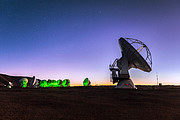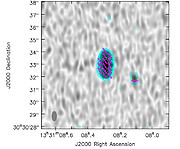Annuncio
ALMA esplora l'Universo magnetico
Le prime osservazioni in polarizzazione completa di ALMA dimostrano la sua capacità di fare polarimetria
19 Luglio 2016
Recenti osservazioni hanno confermato che l'eccellente sensibilità di ALMA e l'accuratezza della calibrazione lo rendono uno strumento di alto livello per fare misure polarimetriche alle lunghezze d'onda millimetriche.
Nonostante ALMA (l'Atacama Large Millimeter/submillimeter Array) sia operativo dal 2011, le osservazioni continuano a verificare aspetti chiave delle prestazioni. ALMA è stato progettato per eseguire polarimetria ad alta sensibilità — misurando la polarizzazione delle onde radio per rivelare le proprietà dei campi magnetici — e gli astronomi hanno recentemente presentato le prime osservazioni in polarizzazione completa con ALMA, confermando che è particolarmente adatto a questo compito.
Per fare ciò, gli astronomi hanno osservato la sorgente brillante 3C 286. 3C 286 è un quasar che si trova a circa 7,3 miliardi di anni luce da noi, è una sorgente molto potente di onde radio ed è stato osservato da molti altri telescopi. L'emissione radio di questo oggetto è nota per essere altamente polarizzata, rendendolo il candidato ideale per testare le potenzialità di ALMA in questo campo. Le osservazioni di ALMA rivelano dettagli mai visti prima e mostrano chiaramente che il campo magnetico è più forte e più ordinato verso le regioni interne del getto che emerge dal quasar. Questo aiuta i ricercatori a capire la struttura del campo magnetico fin nel cuore del quasar, fornendo indizi vitali sui processi fisici che danno luogo all'emissione radio.
“Questa osservazione ha certamente dimostrato le alte potenzialità delle osservazioni polarimetriche con ALMA,” ha detto Hiroshi Nagai dell'Osservatorio astronomico nazionale del Giappone e capo della squadra di verifica. “Si tratta un'importante pietra miliare per il progetto ALMA.”
I campi magnetici sono importanti in molti contesti cosmici ma sono molto difficili da misurare. La polarimetria è uno dei pochi metodi capaci di rivelare i dettagli dei campi magnetici. Tuttavia, la componente polarizzata delle onde radio — la parte misurata in polarimetria — può essere solo una piccola percentuale del flusso radio totale proveniente da un oggetto, e quindi l'alta sensibilità è essenziale per fare polarimetria di precisione. ALMA ha la sensibilità necessaria per fare queste cruciali osservazioni polarimetriche, come ha confermato questo studio.
Ulteriori Informazioni
Questi risultati sono stati pubblicati nell'Astrophysical Journal il 20 Giugno 2016 in un articolo intitolato “ALMA Science Verification Data: Millimeter Continuum Polarimetry of the Bright Radio Quasar 3C 286” di H. Nagai et al.
Il gruppo è composto da: H. Nagai (National Astronomical Observatory of Japan, Tokyo, Giappone), K. Nakanishi (National Astronomical Observatory of Japan, Tokyo, Giappone; The Graduate University for Advanced Studies, Tokyo, Giappone; Joint ALMA Observatory, Santiago, Cile), R. Paladino (INAF-Osservatorio di Radioastronomia, Bologna, Italia), C.L.H. Hull (Harvard-Smithsonian Center for Astrophysics, Cambridge, Massachusetts, USA; Jansky Fellow of the National Radio Astronomy Observatory), P. Cortes (Joint ALMA Observatory, Santiago, Cile; National Radio Astronomy Observatory, Charlottesville, Virginia, USA), G. Moellenbrock (National Radio Astronomy Observatory, Socorro, New Mexico, Stati Uniti), E. Fomalont (Joint ALMA Observatory, Santiago, Cile; National Radio Astronomy Observatory, Charlottesville, Virginia, Stati Uniti), K. Asada (The Academia Sinica Institute of Astronomy and Astrophysics, Taipei, Taiwan) e K. Hada (National Astronomical Observatory of Japan, Toky, Giappone).
ALMA, l'Atacama Large Millimeter/submillimeter Array, un osservatorio astronomico internazionale, è una collaborazione fra l'Europa, la U.S. National Science Foundation (NSF) e gli Istituti Nazionali di Scienze Naturali del Giappone (NINS), in cooperazione con la repubblica del Cile. ALMA è finanziato dall'ESO per conto dei suoi Stati Membri, dall'NSF in cooperazione con il National Research Council del Canada (NRC) e il National Science Council di Taiwan (NSC) e dai NINS in cooperazione con l'Accademia Sinica di Taiwan (AS) e l'Istituto di Astronomia e Scienze Spaziali della Corea (KASI).
La costruzione e la gestione di ALMA sono condotte dall'ESO per conto dei suoi Stati membri, dall'Osservatorio Nazionale di Radio Astronomia (NRAO) gestito dalle Associated Universities, Inc. (AUI) per conto del Nord America e dall'Osservatorio Astronomico Nazionale del Giappone (NAOJ) per conto dell'Asia Orientale. L'osservatorio congiunto di ALMA (JAO: Joint ALMA Observatory) fornisce la guida unitaria e la gestione della costruzione, del commissioning e delle operazioni di ALMA.
Contatti
Hiroshi Nagai
National Astronomical Observatory of Japan
Osawa 2-21-1
Mitaka, Tokyo, Japan
Email: hiroshi.nagai@nao.ac.jp
Peter Grimley
ESO Assistant Public Information Officer
Garching bei München, Germany
Email: pgrimley@partner.eso.org
A proposito dell'annuncio
| Identificazione: | ann16050 |
Our use of Cookies
We use cookies that are essential for accessing our websites and using our services. We also use cookies to analyse, measure and improve our websites’ performance, to enable content sharing via social media and to display media content hosted on third-party platforms.
ESO Cookies Policy
The European Organisation for Astronomical Research in the Southern Hemisphere (ESO) is the pre-eminent intergovernmental science and technology organisation in astronomy. It carries out an ambitious programme focused on the design, construction and operation of powerful ground-based observing facilities for astronomy.
This Cookies Policy is intended to provide clarity by outlining the cookies used on the ESO public websites, their functions, the options you have for controlling them, and the ways you can contact us for additional details.
What are cookies?
Cookies are small pieces of data stored on your device by websites you visit. They serve various purposes, such as remembering login credentials and preferences and enhance your browsing experience.
Categories of cookies we use
Essential cookies (always active): These cookies are strictly necessary for the proper functioning of our website. Without these cookies, the website cannot operate correctly, and certain services, such as logging in or accessing secure areas, may not be available; because they are essential for the website’s operation, they cannot be disabled.
Functional Cookies: These cookies enhance your browsing experience by enabling additional features and personalization, such as remembering your preferences and settings. While not strictly necessary for the website to function, they improve usability and convenience; these cookies are only placed if you provide your consent.
Analytics cookies: These cookies collect information about how visitors interact with our website, such as which pages are visited most often and how users navigate the site. This data helps us improve website performance, optimize content, and enhance the user experience; these cookies are only placed if you provide your consent. We use the following analytics cookies.
Matomo Cookies:
This website uses Matomo (formerly Piwik), an open source software which enables the statistical analysis of website visits. Matomo uses cookies (text files) which are saved on your computer and which allow us to analyze how you use our website. The website user information generated by the cookies will only be saved on the servers of our IT Department. We use this information to analyze www.eso.org visits and to prepare reports on website activities. These data will not be disclosed to third parties.
On behalf of ESO, Matomo will use this information for the purpose of evaluating your use of the website, compiling reports on website activity and providing other services relating to website activity and internet usage.
Matomo cookies settings:
Additional Third-party cookies on ESO websites: some of our pages display content from external providers, e.g. YouTube.
Such third-party services are outside of ESO control and may, at any time, change their terms of service, use of cookies, etc.
YouTube: Some videos on the ESO website are embedded from ESO’s official YouTube channel. We have enabled YouTube’s privacy-enhanced mode, meaning that no cookies are set unless the user actively clicks on the video to play it. Additionally, in this mode, YouTube does not store any personally identifiable cookie data for embedded video playbacks. For more details, please refer to YouTube’s embedding videos information page.
Cookies can also be classified based on the following elements.
Regarding the domain, there are:
- First-party cookies, set by the website you are currently visiting. They are stored by the same domain that you are browsing and are used to enhance your experience on that site;
- Third-party cookies, set by a domain other than the one you are currently visiting.
As for their duration, cookies can be:
- Browser-session cookies, which are deleted when the user closes the browser;
- Stored cookies, which stay on the user's device for a predetermined period of time.
How to manage cookies
Cookie settings: You can modify your cookie choices for the ESO webpages at any time by clicking on the link Cookie settings at the bottom of any page.
In your browser: If you wish to delete cookies or instruct your browser to delete or block cookies by default, please visit the help pages of your browser:
Please be aware that if you delete or decline cookies, certain functionalities of our website may be not be available and your browsing experience may be affected.
You can set most browsers to prevent any cookies being placed on your device, but you may then have to manually adjust some preferences every time you visit a site/page. And some services and functionalities may not work properly at all (e.g. profile logging-in, shop check out).
Updates to the ESO Cookies Policy
The ESO Cookies Policy may be subject to future updates, which will be made available on this page.
Additional information
For any queries related to cookies, please contact: pdprATesoDOTorg.
As ESO public webpages are managed by our Department of Communication, your questions will be dealt with the support of the said Department.


